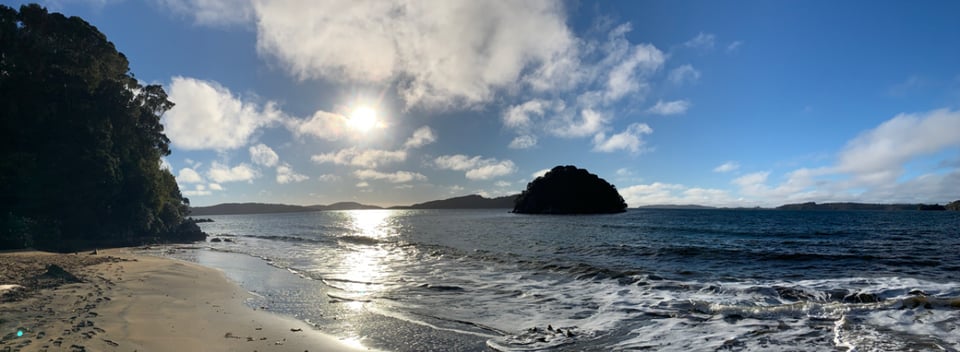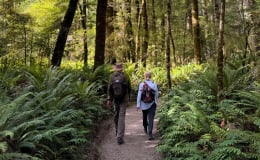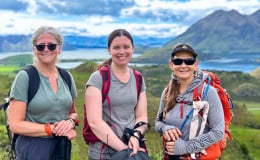
Visiting Ulva Island

Ulva Island is a unique open sanctuary, situated a short 5-minute water taxi ride from Stewart Island. It’s remote location and extensive predator control programs have allowed it to become a pest-free paradise of native rainforest unspoiled by human influence, and home to a wide range of native and endangered wildlife. The waters surrounding Ulva Island make up the Te Wharawhara Marine Reserve, where all marine life is protected, fishing and food gathering is strictly managed to a sustainable level, and no commercial fishing operations are permitted.
A visit to Ulva Island is a must-do for all nature enthusiasts. Explore the island on your own or join us on The New Zealand Great Walk Adventure for a guided trip to Ulva Island, as well as walks on the Rakiura, Milford, Routeburn and Kepler Tracks.
History of Ulva Island
Ulva Island was given reserve status for the preservation of ‘native game and flora’ in 1899, making it one of the earliest reserves of its kind in New Zealand. It was the first part of Rakiura/Stewart Island to receive protection and is an important part of New Zealand’s tourism and conservation history.
The majority of Ulva Island is now included in Rakiura National Park, which was established in 2002. The area around Post Office Bay is still privately owned, however, as it has been since the Post Office was first built in 1872 by Pakeha residents Charles and Jesse Traill. The Post Office was built here as the top of Flagstaff Hill (a highpoint just above Post Office Bay) can be seen from throughout Paterson Inlet. When mail was delivered, the Traill’s would raise a flag on Flagstaff Hill, and residents of the many sawmilling, boat construction and fishing settlements scattered throughout the Inlet would row or sail to Ulva Island to collect their mail. In addition to serving the local communities with mail services, Charles Traill was a keen naturalist and botanist, and was a driving force in the establishment of Ulva Island as a nature reserve.
Walks on Ulva Island

Post Office Bay-Flagstaff Hill Walk: 30-minute loop
A short walk up to the lookout at Flagstaff Point will reward you with panoramic views of Paterson Inlet and across to Stewart Island. The well-formed track then drops down onto the beach at Sydney Cove, where sea lions are often spotted basking in the sun, before cutting back through the forest to Post Office Bay. Information boards along the track give information about the history of the island, and identify the flora that can be spotted alongside the track.
Conservation Walk: 50-minute loop
After following the Flagstaff Point track to Sydney Cove, the Conservation Walk starts halfway along the beach. The track winds through the forest and gives a great glimpse of all the native trees and unique plants that grow on the island. This loop track is the ideal option for those wanting to experience the flora and fauna of Ulva Island at a relaxed pace, with plenty of time for stopping to listen to the birds and enjoying the sights and smells of the forest.
West End Beach Walk: 1.5-2hr loop
The loop walk from Post Office Bay to Boulder Beach, on to West End Beach and back to Post Office Bay is the longest walk on Ulva Island and gives the best opportunity to immerse yourself in the island’s forests and beaches, and to experience all of the unique species of birds and plants. Including time for lots of stops to read the informational boards dotted along the track, to dip your toes in the ocean along the pristine beaches, and to meet the locals (the Stewart Island weka and robins are particularly inquisitive), this walk takes roughly 2 hours. It can be walked in much less time but it is worthwhile taking this walk at a leisurely pace and soaking it all in.
Ulva Island Birdlife

Native bird species whose populations have been in decline in mainland New Zealand for some time are thriving on the island. Species such as the tieke (saddleback), mohua (yellowhead), kaka, kakariki (New Zealand parakeet) and titipounamu (rifleman) which now have low species numbers due to introduced pests like stoats and possums have been introduced to Ulva Island the their numbers have been steadily increasing. The Stewart Island toutouwai (robin), weka and tokoeka (kiwi) and all endemic to Stewart Island and the surrounding small islands, including Ulva Island. Keep an eye out also for many of our other special New Zealand bird species, including the piwakawaka (fantail), pipipi (brown creeper), ngirungiru (tomtit), korimako (bellbird), pihipihi (silvereye), riroriro (grey warbler), torea (oystercatcher), tui, ruru (morepork) and kereru (New Zealand wood pigeon), to name a few!
If you’re an avid bird watcher, Ulva Island is the ultimate place to pay a visit. The birdlife is both abundant and unafraid of humans on the island, creating the perfect environment to get close up and personal with these special birds.
Getting to Ulva Island
Water taxis run from Stewart Island to Ulva Island regularly – at least once an hour during the summer. They depart from Golden Bay Wharf which is an easy 10-minute walk from the main township of Oban, or limited departures also run from the main Halfmoon Bay Jetty and include a tour of Paterson Inlet.
Getting to Stewart Island

Stewart Island is accessed either by ferry or by plane. The ferry journey across Foveaux Strait from Bluff takes you past the small offshore Muttonbird Islands, the breeding ground for hundreds of thousands of Titi (muttonbird or sooty shearwaters). During the hour-long journey keep an eye out for wildlife, including dolphins, seals and numerous seabirds.
Alternatively, take to the skies for a birds-eye view as you take a scenic 20-minute flight from Invercargill. Take in the views of the Fiordland mountains to the west, Stewart Island and its surrounding Muttonbird islands.
What else to do on Stewart Island
Stewart Island may be the smallest of New Zealand’s three main islands, but there are plenty of things to do! Relax and have a drink at the South Sea Hotel, spend the night beneath the Milky Way looking for tokoeka/kiwi, try your hand at pounamu/greenstone carving, explore the local Rakiura Museum, or stretch your legs on the Rakiura Track or one of the island’s many other beautiful short walks. It is well worth staying an extra night or two on Stewart Island to fully appreciate the remoteness and serenity of this unique place. If you’re looking for things to do on Stewart Island, check out our favourite spots and top picks here.
For more information on The New Zealand Great Walk Adventure which includes a trip to Ulva Island as well as day walks on 4 of New Zealand's Great Walks request a free copy of our brochure here!







